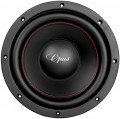Design
—
In the body. Subwoofers consisting of a full-fledged enclosure in which the speaker (speakers) is installed. Usually they are designed to be installed in the boot. Cabinet models are easy to install, but take up a significant amount of space, and in most cases have some phase delay that requires phase adjustment (see below) to synchronize with the front speakers.
—
Without body. This category includes subwoofers designed to work in their own cabinet, but not equipped with it (not to be confused with Free Air — see below). Thus, having bought such a speaker, you can choose a case for it at your discretion — or even make it yourself. This, of course, is more difficult than immediately acquiring a cabinet “subwoofer”, however, it gives more opportunities for adjusting the acoustics to personal preferences. Other advantages and disadvantages of frameless models are similar to case models.
—
Without body (Free Air). Car subwoofers of this type are not only not equipped with a case, but they do not imply its use at all: usually Free Air models are designed for installation in the rear shelf or back of the rear seat, and the boot plays the role of the case. The advantages of such an installation are the minimum space occupied (which is important with small boot volumes), as well as the almost complete absence of delay and the ease of “docking” with the main c
...hannels of the audio system. On the other hand, installing a Free Air subwoofer in itself is associated with a number of difficulties. For example, for the effective operation of such a speaker, the boot must be hermetically separated from the passenger compartment; it is quite difficult to provide such conditions, and in some body types (for example, station wagons) it is almost impossible. In addition, such a speaker has much less ability to adjust to a specific interior than a cabinet one; and with a tightly loaded boot, the sound characteristics deteriorate noticeably. Therefore, paying attention to such “subs” is primarily for owners of sedans who do not have to carry a lot of luggage.Size
The size (diameter) of the main subwoofer speaker. In all types of subwoofers, this parameter primarily affects the power and depth of sound: the larger the speaker, the louder it is and the deeper the bass it can provide (ceteris paribus). However with an increase in the size and dimensions, they increase accordingly, which determines the installation possibilities. The latter is especially true in Free Air subwoofers (see "Execution"): some cars are initially equipped with "seats" for a certain size, and it is difficult to install models with other dimensions there.
Now on the market there are subwoofers with such popular sizes:
5" (13 cm),
6" (15.25 cm),
6.3" (16 cm),
6.5" (16.5 cm),
6.75" (17 cm),
8" (20 cm ),
8.25"(21cm) , 9" (23cm
), 10" (25cm
),
11" (27cm),
12"(30cm) ,
13" (33cm),
15"(38cm) ,
16 " (40 cm),
18" (46 cm).
Frequency range
The range of audio frequencies reproduced by the subwoofer. It is believed that the human ear is capable of perceiving a frequency range of the order of 16 – 20,000 Hz, but in this case note that the subwoofer is designed to reproduce the lower frequency band (up to 200 Hz). Accordingly, in the case of the lower limit of the range, everything is simple: “the lower, the better”; the upper one should not be lower than the lower limit of the main car audio — otherwise there will be "gaps" in the frequencies, which will affect the sound quality.
Sensitivity
Sensitivity determines the loudness of the subwoofer when a signal of a certain power is connected to it: with equal signal power and impedance (see below), the subwoofer with the higher sensitivity will sound louder.
Resonant frequency
The natural frequency of the cone in the subwoofer speaker, namely the frequency with which the cone will oscillate if the speaker is suspended freely in the air and a single impulse is transmitted to the cone (for example, by clicking on it with your finger). In subwoofers, this parameter determines, in particular, the lower limit of the frequency range (see above): at frequencies below the resonant sound power drops sharply. Accordingly, for deep rich bass, the resonant frequency should be as low as possible. This parameter is also used to calculate the size of the enclosure for the subwoofer.
Woofer Diameter
Subwoofer main speaker size. The diameter of the woofer determines the size of the device (see above).
Woofer depth
The size of the main subwoofer speaker from the front (usually the frame protruding beyond the diffuser) to the rear edge (where the magnet is usually located). In practice, it matters when selecting enclosures for frameless models, as well as when installing Free Air (see "Design"): this is the depth to which the speaker will be "recessed" into the enclosure or trunk. And
a flat subwoofer will not always produce less bass than its more voluminous counterpart.

